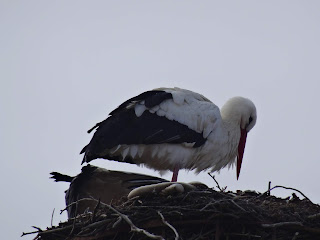102. Brant (or Brent) Goose
Small goose that winters in beaches, sheltered bays, salt marshes and rocky coasts.
101. Great Shag (or Shag)
A great diver! Breeds on rocky coasts of west and south Europe, southwest Asia and North Africa.
Its scientific name Phalacrocorax aristotelis comes from 'phalacros' and 'corax', which mean 'bold' 'raven' in greek. Name aristotelis is given to commemorate the greek philosopher.
A Great Black Cormorant for comparison. Also, an older one here.
100. Rook
Belongs to Corvus, the same family that Crows and Ravens belong to. It is a very sociable and intelligent bird.
99. Pied Wagtail
It is maybe more accurate to be counted as a subspecies of the White Wagtail (no69). Pied Wagtail is White Wagtail's darker relative that breeds in Ireland and the UK. In the winter it migrates south. It is very playful and constantly wags its tail thats why its modern greek name (Λευκοσουσουράδα/Σουσουράδα) is synonym to a "playful girl".
Also, spotted again:
European Robin
The widely distributed across Eurasia Hooded Crow and first bird in my countdown list. Locally it is known as Scotch Crow, Danish Crow, Mist Crow (in Germany) and in Ireland it is called caróg liath or grey crow.
It is different from place to place. The ones spotted in Moscow were huge, while the ones in Greece and Egypt are smaller and brighter/whiter.
Mute Swans with amazingly thick necks!
Juvenile Black-headed gull (notice that they do not show a full black hood yet)
And baby Herring gulls !
Small goose that winters in beaches, sheltered bays, salt marshes and rocky coasts.
101. Great Shag (or Shag)
A great diver! Breeds on rocky coasts of west and south Europe, southwest Asia and North Africa.
Its scientific name Phalacrocorax aristotelis comes from 'phalacros' and 'corax', which mean 'bold' 'raven' in greek. Name aristotelis is given to commemorate the greek philosopher.
100. Rook
Belongs to Corvus, the same family that Crows and Ravens belong to. It is a very sociable and intelligent bird.
99. Pied Wagtail
It is maybe more accurate to be counted as a subspecies of the White Wagtail (no69). Pied Wagtail is White Wagtail's darker relative that breeds in Ireland and the UK. In the winter it migrates south. It is very playful and constantly wags its tail thats why its modern greek name (Λευκοσουσουράδα/Σουσουράδα) is synonym to a "playful girl".
Also, spotted again:
European Robin
The widely distributed across Eurasia Hooded Crow and first bird in my countdown list. Locally it is known as Scotch Crow, Danish Crow, Mist Crow (in Germany) and in Ireland it is called caróg liath or grey crow.
It is different from place to place. The ones spotted in Moscow were huge, while the ones in Greece and Egypt are smaller and brighter/whiter.
Mute Swans with amazingly thick necks!
Juvenile Black-headed gull (notice that they do not show a full black hood yet)
And baby Herring gulls !

















































